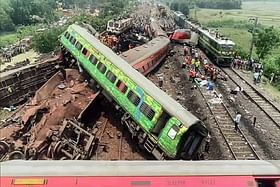The long awaited inquiry report of the Commissioner Railway Safety (CRS) in the Balasore train tragedy has found lapses at multiple levels as the main reason for the accident.
The 40-page CRS report categorically stated that the triple-train collision on 2 June took place owing to lapses in the signalling-circuit alteration carried out at the Bahanaga Bazaar station, which resulted in wrong signal to Coromandel Express.
“These lapses resulted in wrong signalling to Train 12841 (Shalimar-Chennai Coromandel Express), where green signal was indicated for run though movement on UP mail line of the station, but crossover 17 A/B was set to UP loop line. This led to the train traversing on loop line, and eventual rear collision with the goods train,” the report stated.
There was also consequential derailment of train 12864 Yeshwantpur-Howrah Express in this course.
The report sent to the Railway Board has highlighted “lapses at multiple levels” in the signalling and telecommunication (S&T) department, but indicated the tragedy could have been averted if past red flags were taken into account.
The CRS report said, “Notwithstanding the lapses in signalling work, remedial actions could have been taken by the S&T staff if ‘repeated unusual behaviour’ of switches connecting two parallel tracks were reported to them by the station manager of Bahanaga Bazar, the spot of the accident.”
The report also suggested that the non-supply of station-specific approved circuit diagram for the works to replace the electric lifting barrier, at level crossing gate 94 at Bahanaga Bazar station was a “wrong step that led to wrong wiring”.
It said that a team of field supervisors modified the wiring diagram and failed to replicate it.
The report also said that there was a similar incident on 16 May, 2022 at Bankranayabaz station in Kharagpur Division of South Eastern Railway, on account of wrong wiring and cable fault.
The CRS has pointed out that had corrective measures been taken, after this incident, to address the issue of wrong wiring, the accident at Bahanaga Bazar would not have taken place.
The tragic train accident on 2 June resulted in the deaths of 292 people and over 1,000 were left injured.
The CRS report has also said that the initial response to such a disaster should be faster and advised the Railways to review the system of disaster-response in the zonal railways and also the coordination between the zonal railways an various disaster-response forces like NDRF and SDRF.
The report in its conclusion pointed out that the rear-collission was due to the “lapses in the signalling-circuit-alteration” carried out at the north signal ‘goomty’ in the past and during the execution of the signalling work related to the replacement of electric lifting barrier for level crossing gate 94 at the station.
The CRS has recommended that a drive should be launched to update the completion signalling wiring diagrams, other documents and lettering of signalling circuits at site.
Standard practices should be followed for carrying out signalling-modification work. It has also said that any alteration to signalling circuits should be carried out with an approved circuit diagram and in the presence of an officer.
It has further suggested that a separate team should be deployed for checking and testing of modified signalling circuits and functions before restoration and reconnection of the work.


